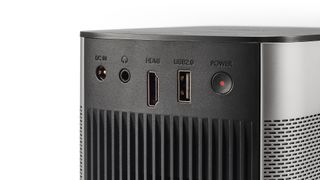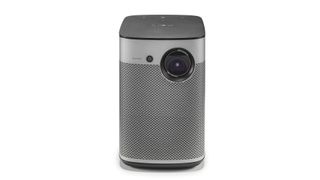If you’ve ever had to pull an all-nighter for work, then you’ll know the taste of the 4am cup of coffee – strong and effective, much like the Xgimi Halo portable projector. Subtlety is not its strongest suit, but it most certainly gets the job done.
Chinese brand Xgimi has been making smart projectors and laser TVs since 2013. Now armed with an impressive array of seven portable projectors, ranging from standard-definition up to 4K, it’s here to take on Epson, BenQ and, most notably, Anker Nebula as the go-to brand for your all-in-one big screen needs.
The Xgimi Halo is just about the midpoint of the series. With its wireless speaker-sized frame, built-in battery, 800 ANSI-lumens LED light source and 1080p HDR output, it could be the home and away portable projector that meets all your needs.
Build

Squint and you could be forgiven for mistaking the Xgimi Halo for an aluminium Sonos One, though the Halo is a little larger at 11cm tall and 15cm wide, and it weighs 1.6kg. It’s about as large as you’d want a portable projector to be before it becomes a hassle to carry around.

Resolution 1080p, HDR, 4K input support
Internal storage 16GB
Brightness 800 ANSI Lumens
Throw ratio 1.2:1
Battery life 2-4 hours
Dimensions (hwd) 11 x 15 x 17cm
Weight 1.6kg
Inside is a 2x 5W Harman Kardon sound system and a DLP projector set-up with a 0.33in DMD (digital micromirror device) at its core. The LED light source is rated to last for 30,000 hours of viewing which translates as eight hours of use per day for the next 10 years – hopefully enough for almost everybody’s needs.
The light is focused by a fixed lens with a 1.2:1 throw ratio that can produce a picture of between 30 and 300in, with a 100in image possible at a distance of 2.67m.
On the outside, there is a single HDMI port (ARC-enabled), a USB and a 3.5mm headphones socket. You can plug in most games consoles, disc players and external speakers, and play files on USB sticks, hard drives, and even from the 16GB of internal storage space. Two-way Bluetooth is available, too, so you can play music through the Halo sound system from your phone or output the projector’s audio signal to a bigger external wireless speaker.
Control of all this and more is through the rather tasteful voice remote control. It includes buttons for direct access to the settings menu and input selection as well as the usual navigation, volume and focus controls too.
There are two other helpful items included. The first is a built-in battery that offers two to four hours of video use, depending on brightness settings, and eight hours of audio playback. Also, tucked underneath is a little kickstand that is useful for angling the Halo up to the right position. The weight of the machine feels quite a lot for a little flap like this and, though it’s fine during our testing, we’re not convinced it would hold up in the longer term.
Features

Like many portable smart projectors, the Halo uses Google’s Android TV 9.0 OS to take care of the apps and menus. Google Assistant provides an effective voice search, and there is also the Chromecast screen sharing technology to fill in most app gaps.
There are a fair few of those, with Netflix, BBC iPlayer, Apple TV, ITV Player, All 4, Now, Apple Music and BBC Sounds all missing. Chromecast can’t stream the Apple services but there are other, free Android TV apps available to help mirror content from iOS.
Setting up the picture projection itself couldn’t be easier. The Halo is fitted with autofocus and auto-keystone. Each time you turn it on, or when its internal gyroscopes detect that you’ve moved it, the 10,000-point AF system springs into life and produces something close to the best possible image, with an impressive keystone correction of up to +/-40 degrees vertically and horizontally.
Like most portables, the Halo runs far quieter than a traditional home cinema projector. It’s rated at less than 30dB and we’re never once distracted by the sound during testing. It’s also 3D-enabled. All you need is some content and a pair of active shutter glasses.
Picture

The minute you switch on the Halo, you get a good idea of just how bright this projector can go. There’s certainly less luminance on the table than with traditional home cinema projectors, but the Halo is a clear step ahead of the entry-level portables, such as the Anker Nebula Mars 2, and pretty much on a par with the more expensive Epson EF-12.
The big, white Xgimi logo is quite blinding with the lights off. We don’t struggle to see what’s going on when we add some ambient lighting and that bodes well for outdoor cinema use, as well as watching sports with friends.
Popping Bumblebee on 4K Blu-ray into our player, that translates to a good, strong picture with plenty of colour saturation. The early scene at the boardwalk funfair is a real treat. The sky is a beautiful sapphire blue, the candyfloss a brilliant synthetic pink and the paintwork of the 1980s cars is a line-up of some wonderful teals, burnt oranges and assorted metallics. At its best, the Halo even has enough skill with colour handling to have skin tones not look out of place either.
However, when the light levels drop, the Halo comes unstuck. Black depth itself is decent, but the detail within those dark zones is scant. The Standard preset gets the most out of the shadows, but even so, we struggle to find much in the way of individual hair strands on Charlie’s head as she rides her scooter off to the scrapyard.
There are similar problems in other areas of this tonally mixed scene. The brightness in the sky behind her is quite blown-out for whites and the shadows in the foreground are strong patches rather than careful shades. There just isn’t enough care in handling the contrast on offer.
The contrast problem is particularly hard going with a film that has any kind of added aesthetic such as Fury in Full HD. The grainy WWII drama is a hard watch on the Halo and there aren’t enough adjustments available to get a picture that’s consistently bright and detailed.
One moment, we have the external scene of the ruined German town square exactly where we want it – some texture to the masonry, a sense of daytime – and the next we’re plunged into a chequerboard of jarring light levels in the apartments where the dead Nazi officers are slumped in their chairs.
It’s even more problematic with standard-def content. We watch Up In The Air on DVD and the upscaling is handled relatively well. Any noise is easily reduced by taking the sharpness setting down and applying a light touch to the Noise Filter, but that heavy contrast is tough to take, with detail even thinner on the ground than before.
The Halo struggles to produce any difference in the blocks of black or navy blue in the suits of the business people in this film. The moment the characters sit on any dark furniture, everything bleeds together and half of each frame can be lost. As impressive as this projector can be at times, at the first sign of a difficult frame the Halo’s big, punchy strengths turn out to also be its most significant weaknesses.
Sound

Sound is a genuine consideration when buying a portable projector. While we’d always recommend upping the ante with a soundbar, headphones or wireless speaker, the 2x 5W Harman Kardon sound system in the Xgimi Halo is largely well appointed and makes an acceptable stopgap for AV and music listening needs.
The Bumblebee soundtrack is a pleasure to listen to through the projector alone. Steve Winwood’s Higher Love provides a real moment of joy as Charlie drives away in her first car, thanks to the decent dynamic ability of the system. There’s plenty of weight and a clear tonal balance that never threatens to get too bright even when we push the volume towards its limits.
Unfortunately, Xgimi has chosen to have the drivers facing forwards on the Halo and that seems an odd choice. The throw distance means you’ll most likely be sitting behind this projector and so the sound will be going the wrong direction. It makes the audio more muffled than it should be but, even in front of the Halo, it is still a touch soft and lacking a little precision compared with the Epson EF-12.
The clicks and whirrs aren’t quite as crisp as they could be when Bumblebee transforms from car to robot in the garage. There is some good spatial sense to the sound as the yellow bot’s metal parts unfold. Details might be placed more clearly in the soundscape if the Halo had a little more organisational know-how.
For this price, it’s the dynamic ability we’re most pleased with. Listening to Know Your Enemy by Rage Against The Machine, there are plenty of dramatic ups and downs and appropriate attacks and crescendos to make the song exciting.
Verdict
The Xgimi Halo makes a good stab at a serious step-up device from entry-level portable projectors, but it doesn’t quite reach a rich and complex level of performance.
Its brightness, battery, storage, speakers and connectivity options mean that, at first glance, it looks the part of a punchy and convenient travel projector. It’s still small enough to throw into your bag, but big enough to give some impact around the house or even in the garden.
But, while it is a decent option for social watching situations, its picture quality just isn’t up to the same standards as those around it. Spend a bit more on the Epson EF-12 and you get a far more sophisticated portable projector. If you need something with a built-in battery, then the Anker Nebula range seems to provide more image subtlety and at a lower price too.
SCORES
- Picture 3
- Sound 3
- Features 4
MORE:
Read our guide to the best projectors
Read our Epson EF-12 review
Read our Epson EH-TW650 review

